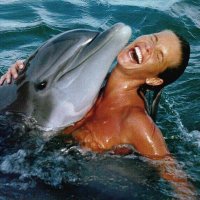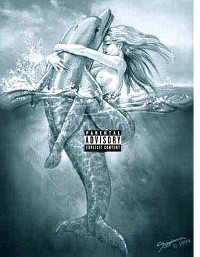***

"The dolphin’s affectionate image was made, not bestowed by nature, as a result of the intertwined and sometimes conflicting interests of science, the military, environmental organizations, and the commercial film and entertainment industries—an image that has had a prolound impact on the shape of scientific research, environmental policy, and international relations in the postwar years.
[It was] known as the “pig fish” or “herring hog” in the early twentieth century by American fisherman to denote its alleged voracious appetite for commercial fish...
Scientific research did not always lend support to the dolphin's career inthe public limelight...
The 1955 film sequel to Creature from the Black Lagoon, Revenge of the Creature, in which both Clint Eastwood and Flippy make their first Hollywood screen appearances, further familiarized mass audiences with the charismatic dolphin. To offer an entertaining and educational experience that the whole family could enjoy, however, Marine Studios had to perform some skillful editing and savvy public relations in the presentation of its star performer. While television shows such as Adventure and Zoo Parade offered visions of nature that conformed to the cult of domesticity found in the 1950s suburban home—with a focus on parenthood, traditional gender roles, and the nuclear family as routes to personal fulfillment—certain aspects of dolphin behavior were not so easily domesticated. Just as the research laboratory at Marine Studios was removed from public sight. so too were certain aspects of the dolphin’s sexual life, kept purposefully behind the scenes.
As early as 1914, Charles Townsend noted that dolphins kept briefly in captivity at the New York Aquarium attempted to mate frequently, although he said nothing more about their sexual behavior. In the first year of Marine Studios’ operation, McBride observed rampant sex play, particularly among males in the tank. In their scientific study on dolphin behavior published in 1948, McBride and Hebb were explicit about the kinds of sexual behavior observed. “Among males,” they reported. “there is a good deal of masturbation, on the floor of the tank and against other males. One male had the habit of holding his erect penis in the jet of the water intake for prolonged intervals. The males also show a good deal of sex play with sharks and turtles, with the appearance of attempted copulation. With the turtle as sex object, the penis is inserted into the soft tissues at the rear of the shell.” Flippy was himself known among Marine Studios personnel for his ceaseless “masturbatory practices.” Often, the sexual aggressiveness of dominant males resulted in the death of other dolphins and specimens in the tank. Herman, the first pilot whale ever to be kept in captivity, for example. was severely injured in 1949 after two bull dolphins and a female continually bit and rammed him into the sides of the tank during the mating season. He died later after a second attack resulted in a broken jaw. After the first live birth of a dolphin in 1947, McBride had to administer large doses of paraldehyde to the bull male in order to curb its frequent attacks on the newborn...

Not surprisingly, footage of female dolphins masturbating with a beach ball by inserting it into their vaginas, shot at Marine Studios for animal psychologist Frank Beach, never made its way to the theater. The image of the dolphin was being cropped for popular consumption.
Scientific research, tourism, and the entertainment industry had turned the dolphin into a highly valued commercial commodity in the 1950s. Typecast as a friendly, playful, highly intelligent mammal of the sea, the dolphin, with its charismatic built—in smile, played its part well. It was a role that capitalized on military, public, and scientific interest in the sea and conformed to the criteria of family fare and moral values widely evident in nature shows on television and the motion picture screen. How different a part it was from the place dolphins occupied in American culture at the turn of the century. When Townsend captured dolphins off the coast of Cape Hatteras for the New York Aquarium in 1914. their only commercial value was for jaw oil used in the lubrication of watches and clocks. In fact, the market for dolphin byproducts was so limited that only a few dolphin fisheries existed in the whole of North America, Even in the lae 1930s, the staff of Marine Studios looked upon dolphins as a cheap and easily accessible specimen for scientific research arid display. But the training of dolphins in the postwar era to assume the role of playmate and close relative to humans significantly increased their value as both experimental organisms and tourist attractions...
The conventions that shape our affections for dolphins have become so thoroughly entrenched and have played such an influential role in shaping marine mammal protection that efforts to shift environmental policy away from a focus on endangered species to ecosystem-processes face difficulty in attracting public support. [Anecdote of 1997, when the Clinton administration tried to move to "a more ecosystem-centered approach to fisheries management"]"
--- Reel nature: America's romance with wildlife on film / Gregg Mitman



